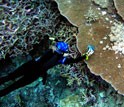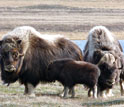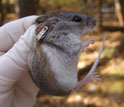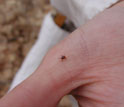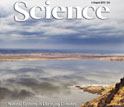News Release 13-138
Infectious diseases and climate change intersect with no simple answers
Study highlights challenges of predicting disease outcomes in a warming world
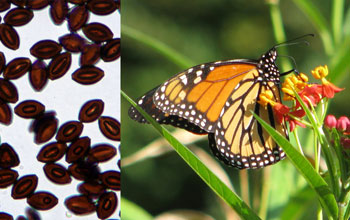
Monarch butterflies carry infections in parts of the U.S. where they breed year-round.
August 1, 2013
This material is available primarily for archival purposes. Telephone numbers or other contact information may be out of date; please see current contact information at media contacts.
Climate change is already affecting the spread of infectious diseases--and human health and biodiversity worldwide--according to disease ecologists reporting research results in this week's issue of the journal Science.
Modeling disease outcomes from host and parasite responses to climate variables, they say, could help public health officials and environmental managers address the challenges posed by the changing landscape of infectious disease.
"Earth's changing climate and the global spread of infectious diseases are threatening human health, agriculture and wildlife," said Sam Scheiner, National Science Foundation (NSF) program director for the joint NSF-National Institutes of Health Ecology and Evolution of Infectious Diseases Program, which funded the research.
"Solving these problems requires a comprehensive approach that unites scientists from biology, the geosciences and the social sciences."
According to lead author Sonia Altizer of the University of Georgia, the issue of climate change and disease has provoked intense debate over the last decade, particularly in the case of diseases that affect humans.
In the Science paper, Altizer and her colleagues--Richard Ostfeld of the Cary Institute of Ecosystem Studies; Pieter Johnson of the University of Colorado; Susan Kutz of the University of Calgary and Canadian Cooperative Wildlife Health Centre; and Drew Harvell of Cornell University--laid out an agenda for future research and action.
"For a lot of human diseases, responses to climate change depend on the wealth of nations, healthcare infrastructure, and the ability to take mitigating measures," Altizer said.
"The climate signal, in many cases, is hard to tease apart from other factors like vector control, and vaccine and drug availability."
In diseases affecting wildlife and agricultural ecosystems, however, findings show that climate warming is already causing changes.
"In many cases, we're seeing an increase in disease and parasitism," Altizer said. "But the effect of climate change on these disease relationships depends on the physiology of the organisms and on the structure of natural communities."
At the organism level, climate change can alter the physiology of parasites. Some of the clearest examples are found in the Arctic, where temperatures are rising rapidly. Parasites are developing faster as a result. A lungworm that affects muskoxen, for instance, may be transmitted over a longer period each summer, making it a more serious problem for the populations it infects.
Climate change is also affecting entire plant and animal communities.
Community-level responses to rising temperatures are evident in tropical marine environments such as the coral reef ecosystems of the Caribbean. Warmer water temperatures have directly stressed corals and facilitated infections by pathogenic fungi and bacteria. When corals succumb, other species that depend on them are affected.
The potential consequences of these changes are serious. The combination of warmer temperatures and altered disease patterns is placing growing numbers of species at risk of extinction, the scientists say.
In human health, there is a direct risk from pathogens like dengue, malaria and cholera. All are linked to warmer temperatures.
Indirect risks also exist in threats to agricultural systems and game species that are crucial for subsistence and cultural activities.
The scientists recommend building on and expanding data on the physiological responses of hosts and parasites to temperature change. Those mechanisms may offer clues to how a system will respond to climate warming.
"We'd like to be able to predict, for example, that if the climate warms by a certain amount, then in a particular host-parasite system we might see an increase from one to two disease transmission cycles each year," Altizer said.
"But we'd also like to try to tie these predictions to actions that might be taken."
Some of those actions might involve more monitoring and surveillance, adjusting the timing of vector control measures and adopting new management measures.
These could include, for instance, closing coral reefs to human activity if a disease outbreak is predicted, or changing the planting strategy for crops to compensate for unusually high risks of certain diseases.
The researchers also point out that certain local human communities, such as those of indigenous peoples in the Arctic, could be disproportionately affected by climate-disease interactions.
Predicting where these local-scale effects might be most intense would allow societies to take measures to address issues such as health and food security.
"Involving local communities in disease surveillance," said Altizer, "could become essential."
-NSF-
-
Biologist studying tumors on coral; climate warming may fuel lethal coral diseases.
Credit and Larger Version -
Muskoxen may be susceptible to arctic climate change and emerging infectious diseases.
Credit and Larger Version -
White-footed mice: the primary reservoir hosts for Lyme disease in the eastern United States.
Credit and Larger Version -
Black-legged ticks, the primary vectors of Lyme disease in the northeastern United States.
Credit and Larger Version -
The researchers' findings are described in the Aug. 2, 2013, issue of Science.
Credit and Larger Version
Media Contacts
Cheryl Dybas, NSF, (703) 292-7734, email: cdybas@nsf.gov
Beth Gavrilles, University of Georgia, (706) 542-7247, email: bethgav@uga.edu
Lori Quillen, Cary Institute of Ecosystem Studies, (845) 677-7600, email: quillenl@caryinstitute.org
Jim Scott, University of Colorado Boulder, (303) 492-7531, email: jim.scott@colorado.edu
John Carberry, Cornell University, (607) 255-5353, email: johncarberry@cornell.edu
Related Websites
NSF Special Report: The Ecology and Evolution of Infectious Diseases: http://www.nsf.gov/news/special_reports/ecoinf/index.jsp
NSF News: Controlling the Spread of Diseases Among Humans, Other Animals and the Environment: http://www.nsf.gov/news/news_summ.jsp?cntn_id=125496
NSF Discovery Article Series: Ecology and Evolution of Infectious Diseases: http://www.nsf.gov/discoveries/disc_summ.jsp?cntn_id=127103&org=NSF
The U.S. National Science Foundation propels the nation forward by advancing fundamental research in all fields of science and engineering. NSF supports research and people by providing facilities, instruments and funding to support their ingenuity and sustain the U.S. as a global leader in research and innovation. With a fiscal year 2023 budget of $9.5 billion, NSF funds reach all 50 states through grants to nearly 2,000 colleges, universities and institutions. Each year, NSF receives more than 40,000 competitive proposals and makes about 11,000 new awards. Those awards include support for cooperative research with industry, Arctic and Antarctic research and operations, and U.S. participation in international scientific efforts.
Connect with us online
NSF website: nsf.gov
NSF News: nsf.gov/news
For News Media: nsf.gov/news/newsroom
Statistics: nsf.gov/statistics/
Awards database: nsf.gov/awardsearch/
Follow us on social
Twitter: twitter.com/NSF
Facebook: facebook.com/US.NSF
Instagram: instagram.com/nsfgov

